Industry, Labour and Employment
Employment
Unemployed situation in Kerala
India has witnessed an impressive GDP growth rate of over 7 per cent since 2014. However, incidence of poverty is still persistent. Employment issues have always been among the priorities because it is considered as one of the important tools to alleviate poverty. An important peculiarity of Indian job market is that majority of workers in India are in informal jobs. Recent statistics revealed that there has been a shift from agriculture & allied sectors to construction sector. According to the 5th Annual Employment-Unemployment Survey 2015-16, Labour Force Participation Rate (LFPR) at all India level is estimated at 50.3 percent under Usual Principal Status (UPS) Approach. Females LFPR is significantly lower as compared to males. It is 23.7 percent as compared to 75 percent for male and 48 percent for transgenders. Similarly, the Worker Population Ratio (WPR) at all India level is estimated at 47.8 percent comprising of 27.7 percent females,72.1 percent males and 45.9 percent for trasngenders.
Kerala has been registering a high income growth rate for quite some time now but it is not translating into creation of job opportunities. It records the highest unemployment rate as per the 5th Annual Employment-Unemployment Survey 2015-16 conducted by Ministry of Labour and Employment, Government of India. According to the survey report, among major states Kerala has the highest Unemployment Rate (UR) of 12.5 as against the all India level of 5 percent ( Appendix 3.59 and Figure 3.46). Only two small States viz; Sikkim and Tripura have a higher unemployment rate than Kerala.
Fig 3.46
Unemployment Rate of major States in India (UPS Approach)

Source: Fifth Annual Employment-Unemployment Survey 2015-16,Government of India.
As per UPS approach, the lowest unemployment rate of 0.3 per cent is estimated in Daman & Diu (UT). Among the states the lowest unemployment rate is estimated in Gujarat (0.9 per cent).The other major states, which have lower UR than the all India average (5 per cent) are Karnataka (1.5 per cent), Chattisgarh (1.9 per cent), Maharashtra (2.1 per cent), Andhra Pradesh(3.9 per cent),Tamil Nadu(4.2 percent), Madhya Pradesh (4.3 per cent) and West Bengal (4.9 per cent). Unemployment in Kerala is found to be high due to various reasons. Different indicators on employment and unemployment pertaining to Kerala and India are shown in Appendix 3.60 and Appendix 3.61.
As per the Survey of Employment and Unemployment Situation in India, (NSS 68th Round), area wise data shows that the unemployment rate is higher in rural areas as compared to urban areas (Figure 3.47).
Figure 3.47
Unemployment Rate in Kerala under Different Approaches
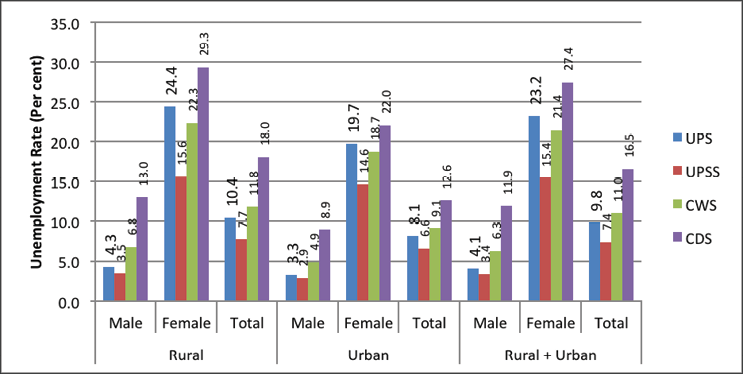
Source: Employment and Unemployment Situation in India, NSS 68th Round, July 2011- June 2012(Age: 15-59 years)
Productive employment of youth is an essential factor for economic development. In Kerala, the youth accounted for around 23 percent of the state’s population. As per the survey report, the UR among the youth in Kerala is much higher as compared to that in the overall population and it reveals the severity of unemployment problem among the youth in Kerala. The UR of the youth is 21.7 per cent for rural areas and 18.0 per cent for urban areas. Similarly, the UR among the female youth is also much higher than that of the male youth. Area wise UR data shows that 47.4 per cent of female are in rural area as against the male of 9.7 per cent. (Figure 3.48). The youth unemployment is prevalent in Kerala because young people lack adequate skills, and work experience in emerging areas. In order to face the challenges the ongoing programmes for skill development and employment generation may be restructured to equip the youth for finding better employment opportunities.
Figure 3.48
Unemployment Rate of the Youth in Kerala and India as per UPSS Approach
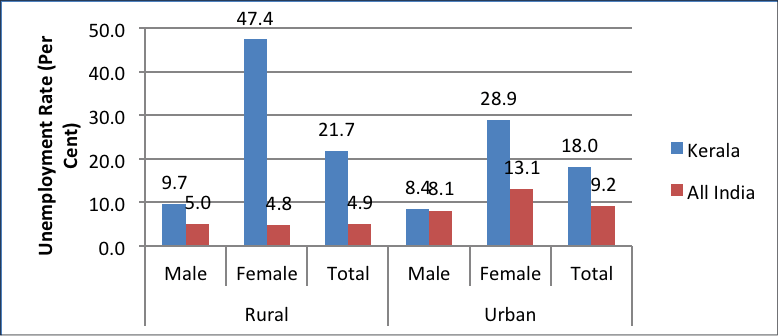
Source: Employment and Unemployment Situation in India, NSS 68th Round, 2011- 2012(Age: 15-29 years)
Employment in the Organized Sector
In Kerala, employment in the organised sector showed a downward trend. For instance, persons employed in organised sector decreased from 12.26 lakh in 2000 to 11.75 lakh in 2016, a reduction of 4 per cent over a period of 15 years. The reason behind the downfall is due to the surfacing of informal sector.
The organised sector comprises private and public sectors and it is noteworthy that private sector employment is steadily increasing since 2011onwards. In 2016, out of 11.85 lakh persons employed in the organised sector 5.75 lakh (48 per cent) are in the public sector and 6.10 lakh (52 per cent) are in the private sector. (Appendix 3.62 and Figure 3.49).
Figure. 3.49
Employment in the Organized Sector- Kerala
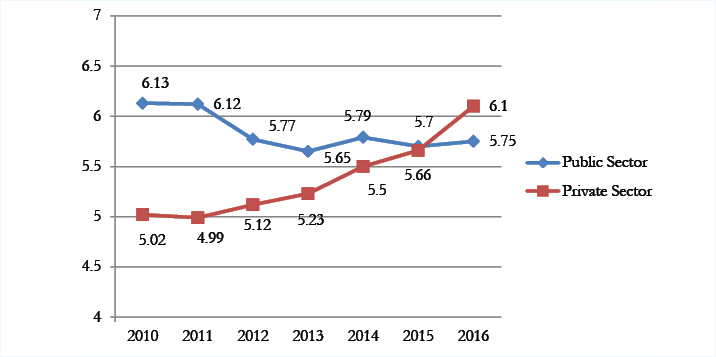
Source: Directorate of Employment, Govt. of Kerala, 2015
Within the public sector employment 47 per cent are employed in State Government and 10 per cent are in Central Government, 22 per cent are in State Quasi Institutions, 5 per cent in LSGI and 16 per cent are in Central Quasi Institutions. (Figure 3.50 and Appendix 3.63).
Figure. 3.50
Distribution of Employment in Public Sector- December 2016
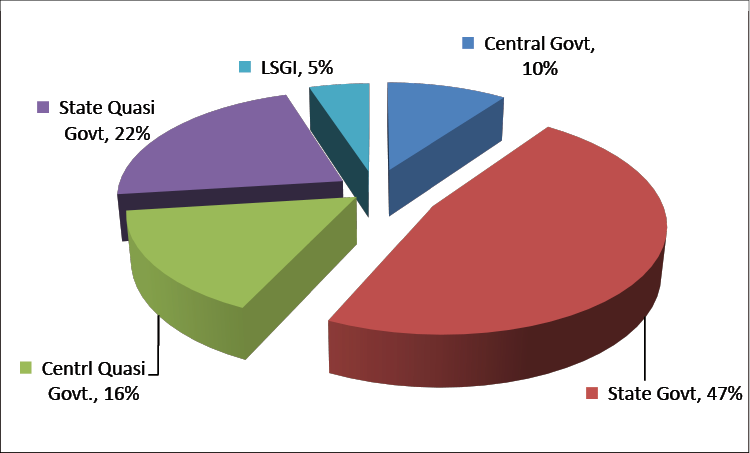
Source: Directorate of Employment and Training, Govt. of Kerala, 2016
Data on district-wise employment as on March 2016 indicate that Ernakulam and Wayanad are the two districts which respectively accounted for the highest and lowest employment. Total organized sector employment in Ernakulum District is 2.28 lakh persons, which accounted for 19 per cent of the total employment of the State. Whereas in Wayanad the employment under organized sector is 27,000 persons, which accounted for 2.3 per cent of the total employment. Men outnumber women in public sector employment as about 67.5 per cent of persons employed in public sector employment are men (See Appendix 3.64 and Appendix 3.65).
Recent statistics on sectoral distribution of workers in organized sector in Kerala indicates that the dependence on service sector continues to rise whereas the dependence on agriculture continues to decline. The employment in agriculture (relative to other sectors) gradually fell from 7.5 per cent in 2005 to 5.6 per cent in 2016. Whereas, the relative share of employment in Community, Social and Personal Services increased from 44.7 per cent in 2005 to 49.5 per cent in 2016 (See Appendix 3.66). This reveals that nearly half of the employment is in the community, social and personal services. Manufacturing sector accounted for 20.7 per cent of employment.
Employment in Unorganised Sector
Unorganised sector plays a crucial role in Indian economy in terms of employment and its contribution to the Gross Domestic Product, savings and capital formation. More than 90 per cent of workforce are in unorganised sector and nearly 50 per cent of the Gross Domestic Product are accounted from the sector. A high proportion of socially and economically weaker sections of society are engaged in the unorganized economic activities in India and Kerala. As per the Employment and Unemployment survey carried out by the NSSO (68th round ) based on UPSS approach it is estimated that self employed workers in Kerala constituted 37.7 per cent of the total workers. Comparatively the percentage share of regular wage/salaried employee accounted for 22.5 per cent and that of casual labour accounted for 39.8 per cent.
Employees of enterprises belonging to the unorganised sector have lower job security, poorer chances of growth, absence of leaves and paid holidays, and lower protection against employers as compared to employees in organised sector. The unorganized workers are subject to exploitation, face poor working conditions and especially earn lower wages much below that in the formal sectors. In Kerala, Directorate of Employment and Training is the nodal department to take measures to reduce instances of unfair practices existing in the unorganized sector. In recent years, the Government has initiated several measures to provide social security to workers in the unorganised sector.
Employment Exchanges and their Services
Registered Job Seekers
According to live register of employment exchanges in Kerala, the total number of work seekers as on December 31, 2012 was 44.99 lakh. But it has now declined to 36.57 lakh as on December 31, 2015, a reduction of about 8.42 lakh. Details of work seekers for various years are given in Appendix 3.67.
Contrary to the all India scenario women are found to be more in the live registers in Kerala. Of the total job seekers 56 per cent are women. Number of illiterate persons in the Live Register is 950. Distribution of job seekers by educational level indicates that only 10.4 per cent have qualification below SSLC. About 58 per cent of the work seekers are in the category of qualifications having SSLC. (Appendix 3.68).
The number of professional & technical work seekers as on October 31, 2016 is 1.70 lakh. Data reveals that ITI certificate holders and Diploma holders in Engineering together constitute 97 per cent of the total professional & technical work seekers. There are 23,984 registered Engineering Graduates (Appendix 3.69).
A significant and peculiar feature of Kerala is that women outnumber men who seek employment through employment exchanges. The district-wise work seekers in Kerala is shown in the Figure 3.51.
Figure 3.51
Work Seekers in Kerala as on 31-12-2015
(Status of Men and Women)
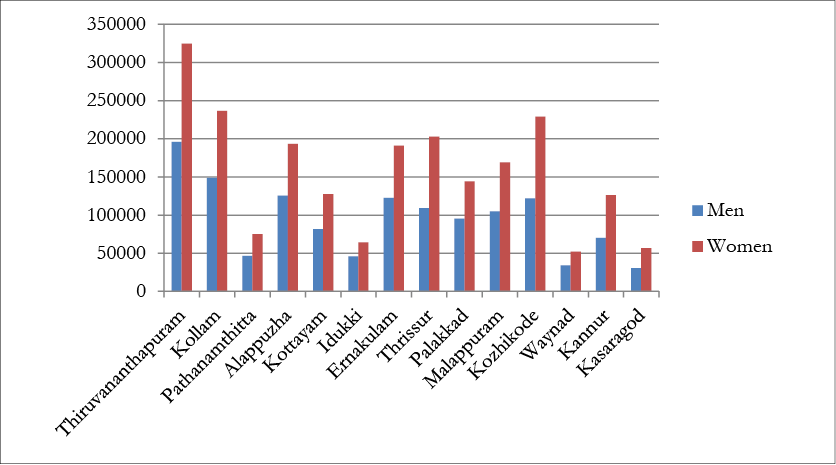
Source: Directorate of Employment and Training, Govt. of Kerala, 2016
Thiruvananthapuram District ranks first in the number of work seekers in general and professional/technical categories as on September 30, 2016. The total number of work seekers in Thiruvananthapuram district is 5.2 lakh; of which 3.24 lakh are women and 1.96 lakh men. The second largest number of work seekers is in Kollam district with 3.85 lakh persons. The lowest number of work seekers registered is in Wayanad with 0.863 lakh persons, followed by Kasaragod with 0.869 lakh persons. (Appendix 3.70).
Self Employment Schemes implemented through Employment Exchanges
Three self employment schemes are implemented through the Employment Exchanges in Kerala.
1. Kerala Self Employment Scheme for the Registered Unemployed (KESRU) is being implemented since 1999 and is intended for unemployed persons in the live register between the age 21 - 50 years with annual family income not exceeding 1 lakh. Preference will be given to those with professional or technical qualifications, graduate women and beneficiaries of unemployment dole scheme. Bank loan up to 1 lakh with a 20 per cent subsidy is given for self employment ventures. During 2015-16 an amount of 1.33 crore was allotted to 736 beneficiaries.
2. Multi-Purpose Service Centres/Job Clubs (MPSC/JC) is a group oriented self-employment
scheme for development of enterprises in the unorganised sector. Bank loan up to 10 lakh with a maximum of 2 lakh as subsidy is given for starting self-employment group ventures of 2 to 5 members, who are unemployed persons in the live registers in the age group of 21-40 years. The scheme is incorporated with Credit Guarantee Scheme. During 2015-16 an amount of 1 crore was allotted to 64 Job Clubs.
3. Saranya is an employment Scheme for the Destitute Women aimed at uplifting the most
backward and segregated women in the State, namely widows, divorced, deserted, spinsters above the age of 30 and unwed mothers of Scheduled Tribe. Under this scheme interest free bank loan upto 50,000 with a 50 per cent subsidy (maximum 25,000) is given for starting self-employment ventures. During 2015-16 an amount of 16 crore was allotted to 3200 beneficiaries.
Niyukthi-2016
Niyukthi-2016 was a Mega Recruitment Drive conducted by the Government of Kerala through the Employment Department. Deviating from the traditional way of conducting job fairs, modern technologies like dedicated software, ‘whatsapp’ technology was used and hitherto-new event-management technology by the government officials, orientation programme for job seekers and pre-employers meet were held at Thiruvanathapuram, Ernakulam and Kozhikode. In this mega event 28,265 jobseekers and 222 employers participated. Out of 17,664 vacancies reported, placement were offered for 14,399 posts.
Unemployment Assistance
Government of Kerala has introduced an unemployment assistance scheme in 1982. Under the scheme, unemployed youths remaining in the live registers for over three years (physically challenged two years) after attaining the age of 18 and having passed SSLC (For the SC/ST & physically Challenged, candidate need to have only appeared for SSLC examination) and having annual family income below 12,000 and personal income below 100 per month are eligible for an unemployment assistance of 120 per month up to the age of 35 years. With the enactment of the Kerala Panchayat Raj Act and Kerala Municipality Act the unemployment assistance scheme was transferred to Rural and Urban Local Governments since 1998. Under the scheme the eligible candidates shall submit their application for unemployment allowance in the prescribed form to the Local Government. The Welfare Standing Committee at the Local Governments may finalise the list of candidates based on the eligibility criteria. In the current year an amount of 15.84 crore was disbursed to 2,03,703 beneficiaries as on November 2016.
Placement through Employment Exchanges in Kerala
The placement through Employment Exchanges in Kerala has been declining since 2010. Total placement has declined from 12,643 in 2010 to 10,303 in 2015 and further to 7,875 as on September 30, 2016. Reduction in placement may be due to temporary posts either being filled up on daily wage/contract basis or being kept vacant. The placement through employment exchanges in Kerala since 2010 is illustrated in the Figure 3.52.
Fig 3.52
Placement through Employment Exchanges –Kerala
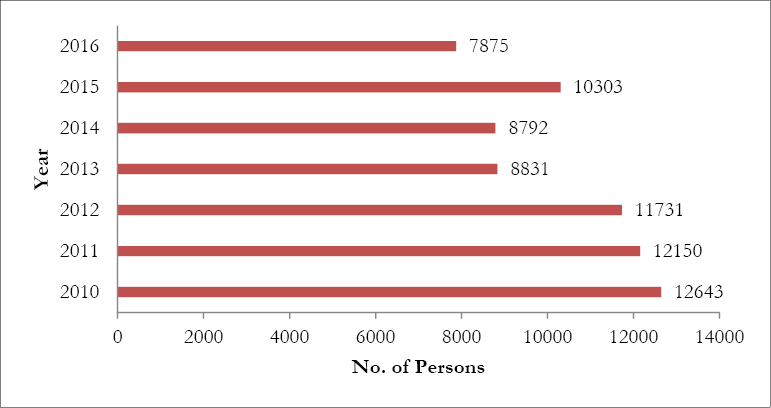
Source: Directorate of Employment and Training, Govt. of Kerala, 2015
The mismatch between the State Domestic Product (SDP) and employment elasticity has led to rising unemployment rate in Kerala leading to an unemployment rate which is over two times of the all India average. In Kerala, unemployment rate is much higher among females as compared to males despite remarkable women empowerment and poverty alleviation initiatives. An entrepreneur culture must be evolved to increase the employability of the labour.
Building resilient infrastructure, promoting inclusive and sustainable industrialization and fostering innovation is one of the sustainable development goals. MSMEs in the State have emerged as a crucial sector in providing employment and promoting industrialization. The State needs to create a conducive environment for the industries to thrive and encourage the growth of MSMEs as a driver of industrialization in the State. Traditional industries need to be strengthened and appropriate promotional strategies needs to be devised. The potential of the labour force also needs to be adequately tapped so that its productively is enhanced. The improving trends in industrial climate in the state will help to propel industrial growth and productivity. The State needs to frame appropriate policies which take into account the changing labour dynamics in the State and create more job opportunities to reduce the prevailing high unemployment rates.

